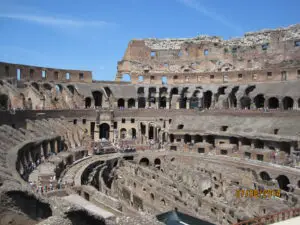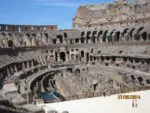Have you ever heard the term that in the past salt was worth its weight in gold? I sure have. But was that really the case? How valuable was salt in Antiquity and how was it produced?
Salt was produced in salt evaporation ponds on the coast and generously used by the Romans. In 150 BC the Roman writer Cato the Elder recommended that 1 modius of salt (roughly 22lbs/10 kg) should be stored per family member and year and a little less should be stored for each slave. In the year 47 AD one Metron (8lbs/3,65kg) of salt did cost 0,86 sesterces which was the equivalent of 100 figs. 1 Modius (13,8lbs/6,29kg) of wheat flour did cost 20 sesterces.
Let`s take a closer look!
The production of salt in Antiquity
When it came to the production of salt then Italy and the Roman Empire which in large parts was centered around the Mediterranean sea had several advantages over the Holy Roman Empire. The reason for that is simple, most of Italy is not more than 60 miles away from the coastline and the Mediterranean weather is well suited for harvesting salt in salt evaporation ponds.
However in the Holy Roman Empire that was not really possible so instead salt was usually produced by the exploitation of natural underground salt deposits. Needless to say that that made the production of salt harder. For more information on that and how that influenced the price of salt in the Middle Ages, I would like to recommend you my article here.
In Antiquity salt was mostly produced in salt evaporation ponds. Salty seawater was fed into shallow ponds where it evaporated under the Mediterranean sun leaving behind the salt. Because of its location Italy never had to import salt for consumption, only special salts like rock salt from Cappadocia or Spain and fossil salts from the Siwa Oasis that were used for medical purposes were imported in small quantities
By the way. The production of salt in salt evaporation ponds had already been practiced by the Romans around the time of the mythological founding of the city of Rome. For more information on both the founding myth and the reality of how Rome was founded, I would like to recommend you my article here.
In that article, I also talk about the beneficial geographical position of Rome. One of the reasons why the position of Rome was so beneficial had to do with salt since Rome was an important station on the Via Salaria, the salt road used to bring salt from the salterns at the coast to central Italy. Needless to say that such a position on a major trade route and the money that came along with it was a major benefit for the development and expansion of Rome.
Do you want to find out more about the often overlooked (but incredibly important) early expansion of Rome? Then I would like to recommend you my article here.
The sea salt that was produced in the salt evaporation ponds was called sal niger (dark salt) because of its grey color. It was sold (and since the rule of Ancus Marcius also partially distributed for free) and then cleaned by the recipients at home.
Have you ever heard of Ancus Marcius? He, according to Rome’s founding myth, was the fourth king of Rome. For more information on him and the founding of Rome you can check out my article here.
Sometimes the salt was also refined by adding spices.
But most of the time pure salt which the writer Horace called sal purus was consumed.
The use of salt in Antiquity
When it came to the consumption of salt then there were basically two options. Either the salt was consumed as a seasoning, or the salt was used to preserve foods that could easily spoil like olives, fish, or meat. For more information on how much salt was needed to cure 1 pound of fish or meat, you can check out my article here.
It is actually quite interesting that while salt was generously used to cure meat and fish Romans in general preferred a sweet cuisine. So honey was often brushed on cured meat to make it less salty. Here you can find out more about the price and use of honey and other sweeteners in Antiquity.
Romans used salt to produce Garum (kind of an ancient instant-seasoning), to preserve olives, fish, and meat, but also consumed it pure as seasoning.
So Romans consumed a lot more salt than is currently recommended. In 150 BC Cato the Elder wrote his book De Agri Cultura in which he recommended storing 1 modius of salt (roughly 22lbs/10 kg) per person and year. So each person could have consumed 18,5 grams of pure salt (not counting the salt for curing meats) per day. Today 7-8 grams are recommended.
And while Cato recommended that a little less salt should be stored for each slave that still shows that salt was indeed widely available in Antiquity, even for slaves and poor Romans.
That is also supported by Horace who mentioned that during the early stages of Rome a dish made of bread and salt was a common breakfast and was still consumed by the poor during the Roman Republic. For more information on the diets and breakfasts of poor Romans, I would like to recommend you my article here.
The fact that both slaves and poor Romans were supplied with generous amounts of salt obviously opens up another question. And that is the question of how expensive salt was in antiquity and whether or not it was really worth its weight in gold.
The price of salt in ancient Rome
Well, the fact that Cato the Elder recommended storing a little less than one Modius of salt (22 lbs) per year and slave and that a dish made of bread and salt was eaten by poor Romans should already tell us something about the price of salt in ancient Rome.
Salt in ancient Rome was not worth its weight in gold. In Egypt, in the year 47 AD one Metron (8lbs/3,65kg) of salt did cost 0,86 sesterces which was the equivalent of 100 figs. 1 Modius (13,8lbs/6,29kg) of wheat flour did cost 20 sesterces.
Now granted, these numbers are not for the city of Rome. But I think due to Rome’s position close to the salt evaporation ponds and on the Via Salaria, the salt road, the numbers for Egypt are also applicable to the city of Rome.
So it shows that salt was not only rather affordable but also widely available in Rome. Do you want to find out how the fall of the Western Roman Empire affected the price of salt in Western Europe? Then I would like to recommend you my article here.
Take care of yourself because you deserve it. You really do.
Until next time
Yours truly
Luke Reitzer
Sources
J. Andre: Essen und Trinken im Alten Rom (Stuttgart 1999).
H. Freis: Historische Inschriften zur römischen Kaiserzeit von Augustus bis Konstantin (Darmstadt 1994).

